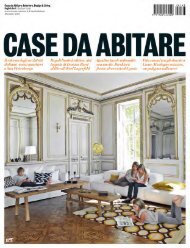Create successful ePaper yourself
Turn your PDF publications into a flip-book with our unique Google optimized e-Paper software.
Opening up<br />
One of the <strong>gardens</strong> where this was done to<br />
perfection was Painshill in Surrey. Created<br />
in the 1730s by Charles Hamilton (one of<br />
Bartram’s customers), Painshill was famed<br />
for the painterly use of American exotics.<br />
Shaded pathways gave way to perfumed<br />
shrubberies, while, in autumn, the blazing<br />
foliage of Bartram’s deciduous trees<br />
contrasted with the thousands of American<br />
evergreens that Hamilton had raised from<br />
seed. These made a mottled tapestry of<br />
greens, ranging from sombre dark shades<br />
to almost yellow: a picture so perfect that<br />
Hamilton enjoyed it twice, seeing it<br />
reflected in the silver surface of the lake<br />
that cut through Painshill.<br />
Everywhere in England, gardeners were<br />
painting with the American species - even<br />
Capability Brown, the man who would be<br />
remembered for creating the archetypical<br />
English landscape garden. At Petworth in<br />
Sussex, Brown created ‘a heavy-timbered<br />
American forest’; and at Tottenham Park in<br />
Wiltshire, he planted evergreen American<br />
cedars, white pines and balsam fir, as well<br />
as spring-flowering tulip trees, and sumachs<br />
that turned flamboyantly red and orange<br />
in autumn. Later, Brown would also<br />
tinge Burton Constable in Yorkshire with<br />
brilliant autumn colours from American ash<br />
trees, sugar maples and scarlet oaks.<br />
American plants became so popular in<br />
England that Peter Collinson had his<br />
garden emptied by thieves several times.<br />
To deter criminals, Collinson and his<br />
horticultural friends had a Parliamentary<br />
Act passed in 1766 whereby plant thieves<br />
could be punished with transportation to<br />
the penal colonies. The proceedings of the<br />
Old Bailey show that several thieves were<br />
sent away ‘for plucking up, digging up,<br />
breaking, spoiling, and carrying away’<br />
flowers, shrubs and trees.<br />
history: georgian<br />
ABOVE Plants and seeds were transported back from America in boxes, crates, modified barrels and<br />
baskets - these reproduction versions are on display at Painshill. ABOVE RIGHT The evergreen borders<br />
include native American conifers and shrubs such as Juniperus communis, cistus, Ilex aquifolium,<br />
Cupressus sempervirens, Rhamnus alaternus and Laurus nobilis.<br />
By the time Bartram died in 1777, the<br />
English garden had been completely<br />
transformed, and had become so fashionable<br />
that its plants and designs were exported<br />
abroad. In France and Germany, Italy and<br />
Russia, gardeners recreated ‘le jardin<br />
anglais’, ‘der Englische Garten’, and ‘il<br />
giardino inglese’ - ironically all consisting of<br />
Bartram’s American trees.<br />
Andrea Wulf’s The Brother Gardeners & The Founding<br />
Gardeners (Windmill Books) are out now.<br />
Intriguing introductions from America were grown by Charles Hamilton from seed sent back from Philadelphia. Many gave incredible autumn colour or late<br />
and early season flowers, and the range of evergreens offered interest for winter. CLOCKWISE FROM TOP LEFT A bloom of American shrub Hypericum<br />
prolificum post-flowering; Cornus florida; scarlet oak Quercus coccinea; Acer saccharum; black oak Quercus velutina; Rhus typhina, the stag’s horn sumach.<br />
February 2013 the english garden 61
















